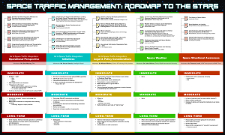Improved Tracking of Resident Space Objects Using the ERAU OSCOM System
Presentation Type
Poster
Location
Henderson Welcome Center
Start Date
15-1-2018 8:00 AM
Abstract
Optical and Spectral characterization of CubeSats for Operational Missions (OSCOM) is a system that uses custom software and inexpensive commercial off the shelf (COTS) equipment to perform space situational awareness tasks for resident space objects (RSO), such as photometry and resolved imaging of larger satellites. Current version of the OSCOM software includes two program pieces: Pre-Tracking and Tracking. The Pre-Tracking program obtains two-line orbital elements (TLE) of satellites and propagates their paths to display the list of objects that are passing over the specified location during the selected time period. This list of satellites is presented on a Graphical User Interface (GUI) and can be customized by utilizing filters such as illumination, satellite and orbit types. The Tracking part of the program is capable of performing satellite imaging, and then commanding the telescope mount to follow the propagated path. This software piece also features the GUI that allows the user to control the tracking process. Additionally, another program has been in development, which focuses on the implementation of the optical feedback. The optical feedback is required for future versions of the OSCOM software that is planned to operate completely autonomously. The implementation of the optical feedback within OSCOM has been heavily dependent upon interfacing with the camera and getting proper function of tracking equipment during TLE assisted tracking. The optical feedback is yet to be field tested, but its use on previously recorded image data to shows that satellites were recognized by object detection algorithms.
Improved Tracking of Resident Space Objects Using the ERAU OSCOM System
Henderson Welcome Center
Optical and Spectral characterization of CubeSats for Operational Missions (OSCOM) is a system that uses custom software and inexpensive commercial off the shelf (COTS) equipment to perform space situational awareness tasks for resident space objects (RSO), such as photometry and resolved imaging of larger satellites. Current version of the OSCOM software includes two program pieces: Pre-Tracking and Tracking. The Pre-Tracking program obtains two-line orbital elements (TLE) of satellites and propagates their paths to display the list of objects that are passing over the specified location during the selected time period. This list of satellites is presented on a Graphical User Interface (GUI) and can be customized by utilizing filters such as illumination, satellite and orbit types. The Tracking part of the program is capable of performing satellite imaging, and then commanding the telescope mount to follow the propagated path. This software piece also features the GUI that allows the user to control the tracking process. Additionally, another program has been in development, which focuses on the implementation of the optical feedback. The optical feedback is required for future versions of the OSCOM software that is planned to operate completely autonomously. The implementation of the optical feedback within OSCOM has been heavily dependent upon interfacing with the camera and getting proper function of tracking equipment during TLE assisted tracking. The optical feedback is yet to be field tested, but its use on previously recorded image data to shows that satellites were recognized by object detection algorithms.

